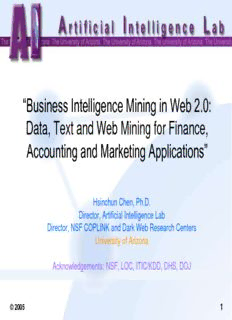
Business Intelligence Mining in Web 2.0: Data, Text and Web Mining for Finance, Accounting and ... PDF
Preview Business Intelligence Mining in Web 2.0: Data, Text and Web Mining for Finance, Accounting and ...
“Business Intelligence Mining in Web 2.0: Data, Text and Web Mining for Finance, Accounting and Marketing Applications” Hsinchun Chen, Ph.D. Director, Artificial Intelligence Lab Director, NSF COPLINK and Dark Web Research Centers University of Arizona Acknowledgements: NSF, LOC, ITIC/KDD, DHS, DOJ © 2005 1 My Background • NCTU SUNY Buffalo NYU U Arizona (MIS #4) • MS, MIS, Design Science, AI, Search Engine, Digital Library, Medical Informatics, Intelligence & Security Informatics, Business Intelligence • AI Lab, 25+ researchers; $25M funding ($1.5M/year), 180 top SCI papers (20+ papers/year); DL (#1), MIS (#8); Scientific Advisor: NLC, NLM, Academia Sinica; Chair, ICADL, IEEE ISI • AE in ten top SCI journals, IEEE and AAAS Fellow • DL/SE; GeneScene & BioPortal; COPLINK & Dark Web (NYT, USA Today, Associated Press, etc.); Knowledge Computing Corporation ($100M) • Business Intelligence Mining??? © 2005 2 The Peta Age The End of Theory © 2005 3 Outline • Web 2.0 + Data Mining, Text mining, Web mining • Intelligence and Security Informatics • Case Studies, Examples, and Lessons Learned: Business Intelligence Data, Text and Web mining • Opportunities and Future Directions: Finance, Accounting, and Marketing Applications © 2005 4 Web 2.0, Data Mining, Text Mining, and Web Mining © 2005 5 Web 2.0, by O’Reilly • http://www.oreilly.com, “What is Web 2.0? Design Patterns and Business Models for the Next Generation of Software,” by Tim O’Reilly, 9/30/2005 (O’Reilly Media Web 2.0 Conference, 2004) • Examples of Web 2.0: Google AdSense, Flikr, Napster, Wikipedia, blogging, search engine optimization, web services, participation, tagging (folksonomy), syndication, etc. 6 © 2005 6 Web 2.0, by O’Reilly • Strategic positioning: “The Web as Platform” • User positioning: “You control your own data” • Core competencies: – Services, not packageg software – Architecture of participation – Cost-effective scalability – Remixable data sources and data transformations – Software above the level of a single device – Harnessing collective intelligence 7 © 2005 7 Web 2.0 Lessons • The value of the software is proportional to the scale and dynamism of the data it helps to manage. • Leverage customer-self service and algorithmic data management to reach out to the entire web, to the edges and not just the center, to the long tail and not just the head. • The service automatically gets better the more better use it. • Blogging and the wisdom of the crowds. • Network effects from user participation are the key to market dominance in the Web 2.0 era. • We, the media. • Data is the next Intel inside. 8 © 2005 8 Web 2.0 Lessons (cont’d) • Operations must become a core competency. • The perceptual beta. • Support lightweight programming models that allow for loosely coupled systems. (SOAP, REST, AJAX, etc.) • Think syndication, not coordination. • Innovation in assembly. The Mashups. • Design for “hackability” and remixability. • Some rights reserved. 9 © 2005 9 Web 2.0, Wikipedia • “Web 2.0 is a trend in the use of the WWW technology and web design that aims to facilitate creativity, information sharing, and collaboration among users.” • “Web 2.0 is the business revolution in the computer industry caused by the move to the Internet as platform, and an attempt to understand the rules for success on that new platform.” 10 © 2005 10
Description: